

Hepatic Microvascular Dysplasia or Portal Atresia. Skip to main content Text Size Current Size: 100%

Newman's Own Chicken & Rice Sticks Dog Treats - «Nutritious and Safe Treats for Dogs» Safe Treats for Dogs and Cats. This week, the FDA released a “progress report” on its investigation into jerky treats.

The update is essentially that there is no progress and it’s still a “buyer beware” situation for anyone who feeds chicken, duck, turkey or sweet potato treats made from China to their pets. You can read the full report here, but as of September 24, 2013, FDA has received more than 3000 complaints of illness related to consumption of chicken, duck, or sweet potato jerky treats, nearly all of which are imported from China. The reports involve more than 3600 dogs, 10 cats and include more than 580 deaths. Search Results Treats. Caring for Your Pet After Surgery. Once your pet is out of the operating room and on his way home, it’s up to you to help him feel more comfortable, so the healing process can begin.
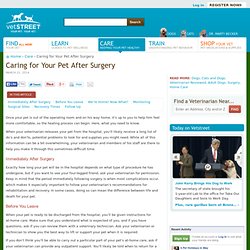
Here, what you need to know. When your veterinarian releases your pet from the hospital, you’ll likely receive a long list of do’s and don’ts, potential problems to look for and supplies you might need. While all of this information can be a bit overwhelming, your veterinarian and members of his staff are there to help you make it through this sometimes-difficult time.
Emergency Crate Training... and more. If your dog makes the decision to STAY in the crate and not rush back out, click and toss a few treats into the crate.
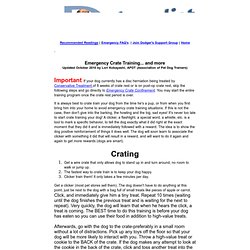
Continue to click and treat your dog for making the decision to stay in the crate. 01 Post-Operative Care for Pets. Authored by: Nanette Walker Smith, MEd, RVT, CVT, LVT After your pet has surgery, post-operative care is critical in terms of comfort, safety, and recuperation.

Elbow fracture. Frequently Asked Questions After Surgery When should my dog have the first bowel movement after surgery?
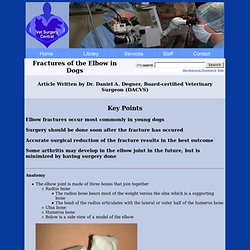
Many dogs will not have a bowel movement for the first 4 to 5 days after surgery Reasons that a dog will not have regular bowel movements after surgery include: The dog has been fasted prior to surgery Dogs do not eat well during the hospital stay They frequently do not eat well when they go home They are fed highly digestible food that produces little stool Pain medication that contain narcotics (such as morphine, fentanyl patches, and tramadol) can be constipating If a pet does not have a bowel movement on the 5th day of being home, a stool softener such as metamucil can be fed Dose of metamucil is 1 tsp per 25 Kg mixed in with each meal (canned dog food); feed immediately after mixing, as the metamucil will gel the food and may make it less palatable My pet had surgery and will not eat.
What can be done? 23mast. Small Animal Surgery Secrets. Repair of a Lateral Humeral Condyle Fracture in a Puppy. The case report in this folder is posted as a guide to what makes an acceptable case report.
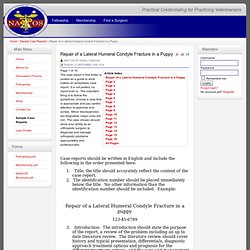
It is not perfect, no report ever is. The important thing is to follow the guidelines, choose a case that is appropriate and pay careful attention to grammar and syntax. Minor discrepancies are forgivable, major ones are not. The case chosen should show your ability as an orthopedic surgeon to diagnose and manage orthopedic problems appropriately and professionally. Case reports should be written in English and include the following in the order presented here: 1. Pet Information - Midland Bullsbrook Veterinary Services. The most common causes of bone fractures in dogs and cats are being hit by a car or falling from a height.

Possible signs of a fractured leg The symptoms will depend on the location of the fracture Misshapen or visible out-of-place of joint Limited mobility Unable to move a limb or it hangs limply Refuse to sit or lie down Cannot support body weight Swelling or swollen areas Bleeding, bruising Licking and whining Intense pain. Pet Loss - Poem List. The Last Battle. Liver and Spleen Cancer (Hemangiosarcoma) in Dogs. Hemangiosarcomas of the spleen and liver are highly metastatic and malignant vascular neoplasms (tumors in the blood vessels) that arise from the endothelial cells (the cells that line the interior surface of blood vessels).
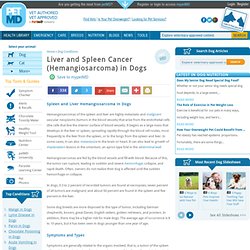
It begins as a large mass that develops in the liver or spleen, spreading rapidly through the blood cell routes, most frequently to the liver from the spleen, or to the lungs from the spleen and liver. In some cases, it can also metastasize to the brain or heart. 01 Splenic Masses in Dogs (Splenectomy) What is the Spleen for?
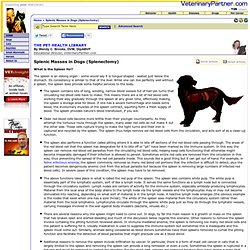
The spleen is an oblong organ - some would say it is tongue-shaped - seated just below the stomach. Its consistency is similar to that of the liver. While one can live perfectly well without a spleen, the spleen does provide some helpful services to the body. The spleen contains lots of long, winding, narrow blood vessels full of hair-pin turns that circulating red blood cells have to make. This means there are a lot of red blood cells working their way gradually through the spleen at any given time, effectively making the spleen a storage area for blood.
Hemangiosarcoma. Hemangiosarcoma[1] is a rapidly growing, highly invasive variety of cancer, occurring almost exclusively in dogs and rarely in cats. It is a sarcoma arising from the lining of blood vessels; that is, blood-filled channels and spaces are commonly observed microscopically. A frequent cause of death is the rupturing of this tumor, causing the patient to rapidly bleed to death. Canine Splenic Hemangiosarcoma: How a Simple Diagnostic Test May Save Lives. According to the Golden Retriever Health Survey, conducted in 1998 and published in 2000, one in five Goldens will develop hemangiosarcoma of the spleen, a malignant form of cancer. In addition, one in eight Golden Retrievers will be diagnosed with another malignant cancer called lymphosarcoma. According to Amy Haase, DVM, writing for Suite101.com: "Current theories about Golden Retrievers are increasing suspicion that this breed may lack a genetic ability to repair damaged DNA over a lifetime, thus explaining the increased tendency for lymphoma and hemangiosarcoma.
" Splenic cancer is silent – evidence that a dog has the disease does not appear on routine blood tests taken to screen for other illnesses like liver or kidney disease. However, an ultrasound can help vets visualize problems with the spleen. Per Dr. Dr. Splenic Tumors. These notes are provided to help you understand the diagnosis or possible diagnosis of cancer in your pet. For general information on cancer in pets ask for our handout "What is Cancer". Your veterinarian may suggest certain tests to help confirm or eliminate diagnosis, and to help assess treatment options and likely outcomes. Because individual situations and responses vary, and because cancers often behave unpredictably, science can only give us a guide.
However, information and understanding about tumors and their treatment in animals is improving all the time. We understand that this can be a very worrying time. Ruptured Spleen in Dogs. A ruptured spleen can be a life-threatening condition in dogs. It usually occurs as a result of serious trauma or severe illness such as cancer. The spleen is an elongated located in the abdominal cavity on the left side and is responsible for filtering blood and for the quality of red blood cells.
Pets 101: Spleen masses and your dog - National Dogs. As responsible dog owners, we do our best to provide a high quality food, regular exercise, consistent vet care, and lots of love. Part of being a good, responsible dog owner is knowing the signs which signify a problem in your dog. Unfortunately, sometimes the problems go un-noticed because the underlying issue does not manifest with symptoms until the situation has become serious.
A mass on your dog's spleen is one such condition which you may not have any awareness of, until it is too late. The spleen circulates a huge quantity of blood through your dog's body. Spleen Mass Question. How to tell if a dog has internal bleeding - by Jane Demerica. Top 10 Warning Signs of Cancer in Dogs and Cats. When your pet dies. When Linda Mickel's 19-year-old cat, Zipper, died, Linda was unprepared for the range of decisions she needed to make. Cremation and Euthanasia Services.